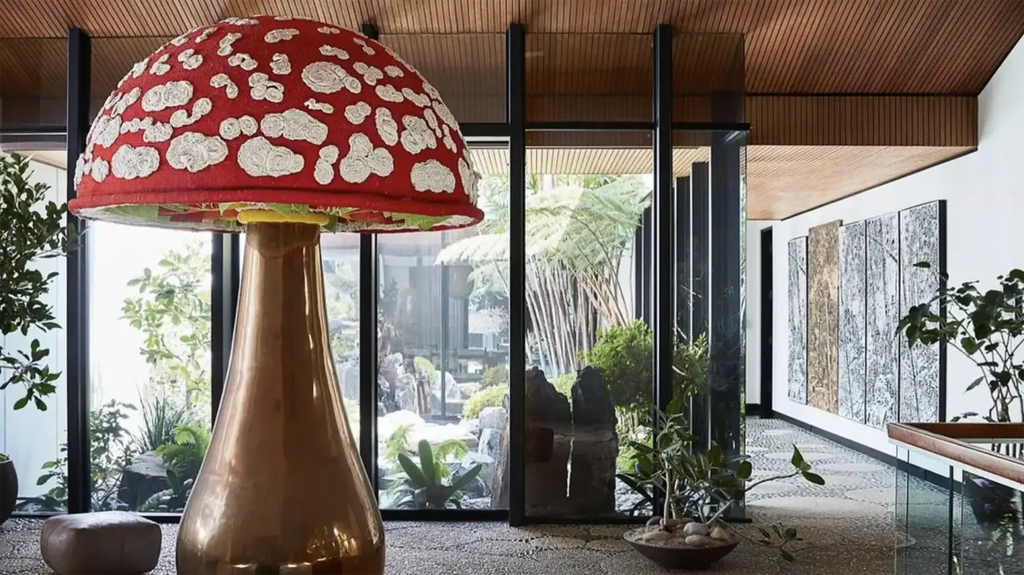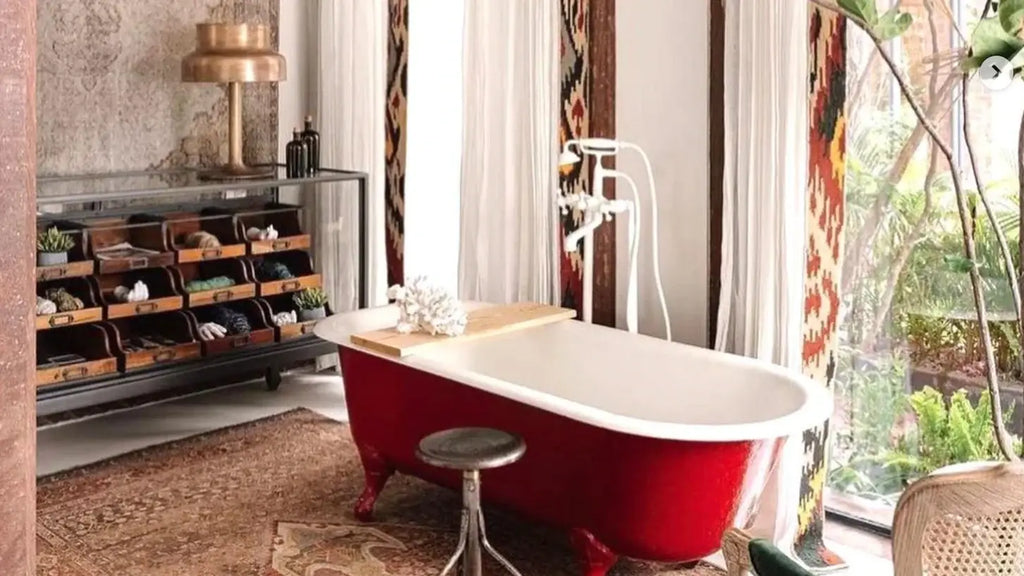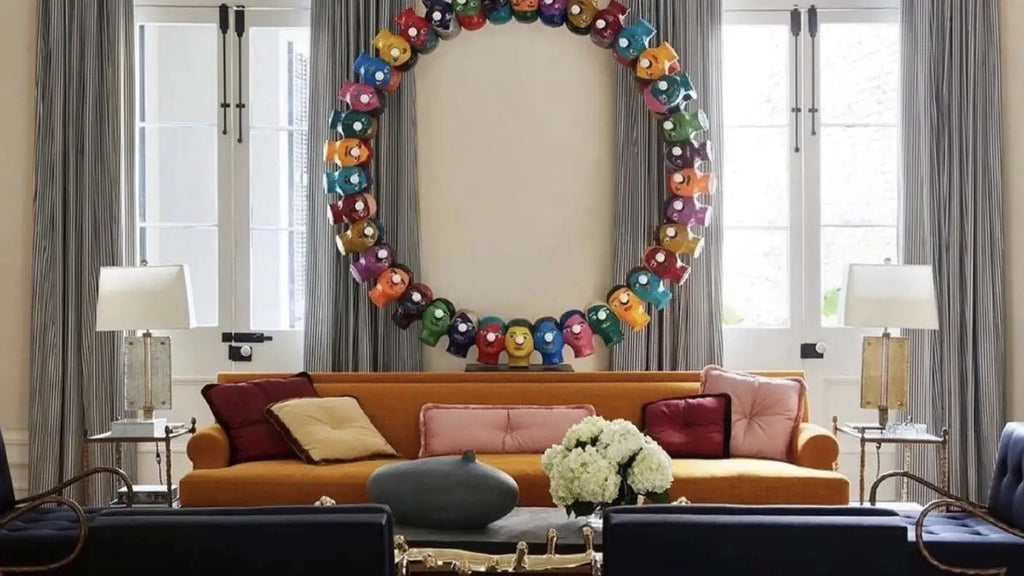Minimalist maximalist design doesn’t play by the rules. It rewrites them in gold leaf and brutalist concrete. It's a paradox clad in velvet and chrome, a tightrope walk between restraint and revelry. At its core, this design language speaks fluent contradiction: editorial excess anchored in stark clarity. It has become synonymous with contemporary luxury, not because it shouts, but because it dares to let silence flirt with spectacle.
In this aesthetic, every item earns its space like a soliloquy on a bare stage. Furniture selection for eclectic spaces isn’t about crowding the room. It’s about letting each piece breathe, burn, and command its own gravitational field. No visual noise. Just intentional drama. Minimalist maximalism doesn’t clutter. It curates impact. It’s the art of making less feel like everything.
This is why it's a darling of celebrity interior designers and creative directors with eyes tuned to negative space and neon. They understand the appeal: living inside a concept, not just a room. Think of it as interior design reimagined as a cinematic set. Every wall a backdrop, every chair a character, every chandelier an exclamation point.
This blog post will guide you through the poetic logistics of achieving this distinctive style, laying out the key interior design tips that make mixing minimalism and maximalism feel effortless—but never accidental.
Read on to discover how your home can become a stage for your wildest everydaydreams, a space so striking you'll cancel dinner reservations just to stay in and marvel.
Key Takeaways
-
The maximalism aesthetic thrives on intentional curations, combining bold use of color and pattern, layered fabrics, and ornate accents to evoke powerful emotional and visual responses. It’s less about clutter, more about calculated theatricality. Think curated chaos that creates a "wow" reaction through scale, surprise, and symbolic extravagance.
-
The minimalist maximalist aesthetic marries the clarity of clean lines with the richness of bold design elements—a hybrid visual language where opulence meets order. It’s design that stuns without screaming, blending opposing styles into a single cohesive vision.
-
Achieving minimalist maximalist design requires embracing vivid color palettes, bright wallpaper, mixed patterns, statement chandeliers, textural layering, and dramatic focal points—balanced with neutral wall colors and thoughtful restraint for harmony.
-
Blending minimalism and maximalism allows for expressive freedom in homes of any size or style. Whether you're curating a downtown loft or redesigning a countryside villa, it opens space for personal expression, decorative contrast, and an interior rhythm that feels bold, intentional, and beautifully lived-in.
1
Overview of Minimalism and Maximalism
Minimalism and maximalism sit like estranged siblings on opposite ends of the interior design spectrum—one whispers in negative space, the other howls in color and pattern. These two aesthetics don’t just diverge in appearance; they represent different cosmologies of taste. One reduces. One amplifies. Yet together, they open the door to eclectic home design that feels both deliberate and divine.
Minimalism is the art of precision. It strips a space down to its skeleton—clean lines, neutral palettes, a limited number of decorative elements—leaving behind only what’s necessary. It values visual clarity, spatial efficiency, and a kind of sacred simplicity that invites mindfulness into the room. White walls, low-profile sofas, monochromatic accents. The mood is often serene, architectural, and softly disciplined.
By contrast, maximalism thrives on the pleasures of abundance. Bold colors, vivid patterns, dense textures, and eclectic arrangements dominate. This isn’t visual clutter—it’s a layered, meaningful cacophony that allows for emotional exuberance and stylistic risk. It’s about more—but with motive. Interior styling in the maximalist vein is equal parts storytelling and spectacle.
When the two styles converge—as they increasingly do in modern interior design—something strange and magnetic occurs. A white wall becomes the gallery for a riotous tapestry. A minimalist sofa might sit beneath a chandelier shaped like a solar flare. Even furniture selection becomes charged: a single velvet armchair, a surrealist side table, a sculpture masquerading as a lamp.

Quincy Jones home delicately updated by Studio Shamshiri. Via Architectural Digest.
...
Definition and History of Maximalism
Maximalist interior design, as a philosophy, is less a rebellion against simplicity and more a celebration of aesthetic abundance. Its historical lineage stretches back to the Victorian era, when homes became curated showcases of worldly travel, inherited grandeur, and domestic opulence. Rooms layered with damask wallpaper, carved mahogany, tasselled velvet—each object a participant in a grand visual opera.
This wasn’t indulgence for its own sake. It was a form of ornamental storytelling: heirlooms beside imported chinoiserie, gas lamps paired with botanical prints. The goal wasn’t cohesion—it was enchantment. And as decades passed, maximalism shapeshifted.
In the 1920s and 30s, Art Deco brought mirrored surfaces, geometric inlays, and metallic accents into the spotlight. Later, Hollywood Regency added cinematic flair—ornate décor, lacquered finishes, sculptural lighting, and a penchant for theatrical symmetry. These periods didn’t reject excess. They elevated it into opulent design trends that signaled aspiration, creativity, and individuality.
Unlike minimalism, which privileges utility, maximalism is comfortable in the space between beauty and function. It thrives on complexity, embraces saturation, and uses layered interior aesthetics to build rooms that feel alive with personal mythology.
What distinguishes true maximalism is its intent. It’s not a chaotic accumulation of things, but a curated mix of bold visual choices—from flamboyant patterns and luscious textures to oversized artworks and gleaming antiques. Each item is part of a deliberate constellation, designed not to hide, but to highlight.
Maximalism doesn’t whisper. It dazzles. And through every epoch, from parlors to penthouses, it’s remained a defining force in ornamental styling and expressive home décor.
Maximalist Aesthetic Principles
Maximalist interior design operates like a visual aria—complex, intentional, and unapologetically expressive. While some might confuse it with clutter, its aesthetic is a study in curated abundance. At its heart is a commitment to fearless decoration, a willingness to fill space with meaning, memory, and magnificent drama.
The backbone of the style lies in the bold use of color, pattern, and texture—layered like chapters in a tactile narrative. Picture deep jewel tones, neon accents, or entire walls swathed in bright wallpaper printed with serpents, florals, or abstract geometry. Contrast reigns. And it’s not just about shocking palettes—it’s about decorative layering that produces emotion and movement.
Maximalism invites architectural rebellion. You’ll find large-scale art, sculptural lighting fixtures, and ornate accents like gilded mirrors or Rococo consoles that double as sculpture. Mixed patterns are welcomed—animal prints lounging next to florals, tartan rugs beneath chevron upholstery. The rules don’t dissolve; they evolve.
What makes maximalism tick is curation. Every object has purpose: a statement piece that centers the room, a throw pillow embroidered with ancestral memory, a brass lamp shaped like a heron. Even the chaos is compositional.
Maximalist spaces aim to provoke a "wow reaction"—but not through volume alone. They use expressive scale, unexpected material pairings, and symbolic excess to create interiors that surprise, delight, and linger in the memory.
This is interior design as self-portrait. The style invites you to showcase your aesthetic vocabulary without dilution—to turn rooms into stage sets for your imagination. Maximalism isn’t about wealth. It’s about willful creativity, and the courage to be seen.
2
The Fusion: Minimalist Maximalist Design
Minimalist maximalist design is not contradiction—it’s design duality made tangible. This modern hybrid interior approach welds the pared-down discipline of minimalism to the expressive ambition of maximalism, creating a visual rhythm between silence and spectacle.
It’s not about compromise—it’s about controlled contrast. Picture sculptural restraint punctuated by flamboyant gestures: a Brutalist bench beneath a kaleidoscopic painting, or a monochrome console supporting a statement chandelier that blazes like a sunburst.
The balance lies in scale, negative space, and material interplay. Minimalist surfaces become blank canvases for dramatic interventions. Clean-lined architecture becomes the backdrop for bold emotional resonance.
In minimalist maximalist interiors, less isn’t just more—it’s strategic space for opulence to bloom.

Designed by Vaishali Kamdar for the Jaipur Rugs gallery. Photo by Ishi Sitwala. Styled by Samir Wadekar.
...
Characteristics and Defining Elements
Maximalist design is an ode to expressive living—a stylistic rebellion against the antiseptic. And when filtered through the lens of minimalism, it becomes something even more refined: an interior editorial. Every choice is precise, theatrical, and deeply personal. The following are defining traits of minimalist maximalist interiors, where excess is curated, and restraint is ornamental.
-
A more-is-more mentality: At its core, maximalism embraces audacity. Colors, patterns, textures—they collide and cohabitate. But in a minimalist maximalist space, these elements are finely tuned. Instead of crowding every surface, the focus shifts to editorial interiors: bigger statements, fewer distractions. Use oversized artwork, towering floral installations, or monumental furniture pieces to anchor the room, then frame them with restraint.
-
Bold use of color: Saturation takes center stage. From electric fuchsia to forest green, or deep navy lacquer to chrome yellow, bold color palettes can define entire rooms. Use color blocking strategies to isolate tones across walls, upholstery, and art.
-
Pattern and layering: Patterns clash with intention. Leopard print pillows flirt with Persian rugs. Checkerboard tiles sit beside swirling marbles. This is pattern-mixing technique as visual jazz, building rhythm through dissonance and delight.
-
Intentional yet curated design: Maximalism isn’t about accumulation. It’s about narrative. Each piece—whether found object, heirloom, or designer collectible—plays a role. Every surface becomes a story.
-
Wow reaction: Surprise is a tool. Think oversized sculptures in tight corridors or wallpapered ceilings in minimalist bedrooms. These unexpected flourishes prompt emotional engagement and turn passersby into participants.
-
Bright wallpaper and mixed patterns: Florals against stripes. Deco lines beside jungle prints. Wallpaper is no longer backdrop—it’s protagonist. Used selectively, it frames spaces with thematic flair.
-
Ornate accents: Gilded mirrors, rococo cornices, sculptural lighting, jewel-toned upholstery, lacquered cabinetry—each piece adds dimension, drawing the eye across the room like a visual score.
-
Layered fabrics: From crushed velvet to bouclé to raw silk, layered luxury aesthetics create warmth and dimensionality. Drape sofas with contrasting textures; mix matte with sheen; let textile tension enrich your sensory experience.
-
Showcase statement pieces: Invest in conversation starters—furniture or objects that shift the room’s gravitational pull. A surrealist coffee table, a throne-like chair, a brass serpent light fixture. These are not accents; they’re protagonists.
-
Create contrast with neutral walls: Blank space matters. Neutral-colored walls (white, taupe, greige) provide room for maximalist elements to vibrate without overwhelming. They serve as pause points in an otherwise cinematic experience.
-
Strive for balance and harmony: Even in abundance, a room must breathe. Think of it as visual counterpoint—loud paired with quiet, smooth next to ornate, shadow beside shine.
3
Benefits of Blending Minimalism and Maximalism
Merging minimalism and maximalism is more than a stylistic experiment—it’s a philosophy of space that honors contrast as coherence. The benefits extend far beyond aesthetics; they offer practical, emotional, and architectural advantages that can transform how you inhabit your home.

Woven wall by Argentinian artist Alexandra Kehayoglou. Photo Julie Soefer.
...
Versatility
Maximalist design is surprisingly adaptable. Whether you're styling a compact apartment, a heritage brownstone, or a sprawling modernist villa, the decorative fluidity of this style allows it to scale to fit. Its power lies in its responsiveness: by adjusting volume, scale, and material contrast, you can tailor its bold energy to suit the rhythm of your space.
Styling for small spaces no longer requires restraint. With strategic use of vertical layering, sculptural accents, and isolated bursts of pattern and color, even the most modest footprint becomes a canvas for personal grandeur. And in expansive interiors, the same principles apply at a larger scale—statement furniture and large-scale art feel grounded when framed by minimalist architecture.
Personal Expression
The hybrid style is a catalyst for storytelling. It gives you the freedom to showcase your unique interior style, where heritage meets futurism, and memory coexists with modernity. Through bold colors, rich textures, heirlooms, and sculptural new finds, your space becomes an autobiography.
Vibrant hues, vintage pieces, eccentric wall art, or quirky objets d’art—all serve as vehicles of identity. Whether you’re spotlighting a gallery wall of global finds or layering ornate accents with sentimental textiles, personal expression becomes the very substance of the room.
Balance and Harmony
It may seem paradoxical, but maximalism—when filtered through minimalist logic—can yield spaces of profound tranquility. Balance arises from dynamic spatial composition: glossy lacquer juxtaposed with matte stone, floral wallpaper set against white terrazzo floors, crystal chandeliers hovering above brutalist consoles.
Even the most exuberant compositions achieve equilibrium through careful object placement, rhythm in material repetition, and moments of visual pause. Incorporating accent pillows, modular rugs, or customized vintage furniture can bring grounding textures and symmetry to even the boldest room.
Emotional aesthetics are just as vital as functional ones. And the minimalist maximalist ethos invites you to cultivate interiors that feel not just beautiful, but alive—with memory, imagination, and intentional joy.
4
Examples of Minimalist Maximalist Design

French Quarter townhouse in New Orleans, Louisiana. Designed by Shawn Henderson. Photo by Stephen Kent Johnson via Shawn Henderson.
...
Minimalist maximalist design is a genre-bending exercise in visual tension and stylistic storytelling. It’s not a one-style-fits-all approach—it’s a strategy that adapts across rooms, moods, and scales. Here are five evocative examples where simplicity and boldness coalesce into fully realized spaces:
Brightly colored living room
A quintessential minimalist maximalist living room often begins with a foundation of white walls or pale oak paneling—a quiet envelope that allows saturated pieces to command attention. A cobalt velvet sofa, blush pink reading chairs, or a mirrored coffee table set the tone for color-saturated focal points. These vivid insertions are made legible by the architectural restraint around them.
Gallery-inspired dining room
This space leans on large-format art to dictate mood. An oversized abstract canvas becomes the gravitational center. Dining chairs might be upholstered in burnt orange velvet, or perhaps an accent wall is painted aubergine behind floating oak shelves displaying rare ceramics. The room reads like an editorial home setting, curated rather than staged.
Eclectic bedroom
A minimalist maximalist bedroom doesn’t shy away from layering periods, finishes, and fantasy. Picture a tufted headboard in emerald green against a wall clad in bold wallpaper—perhaps toile de Jouy meets Bauhaus grid. Nightstands might be brutalist plinths or antique chests. It’s a mix of eras, executed with clarity and conviction.
Ornate home office
In this setting, high-gloss furniture like lacquered desks or chrome shelving brings polish to what might otherwise be a utilitarian zone. A statement chandelier, baroque-framed mirror, or a Persian rug layered over terrazzo floors injects luxury into the workaday. The tension between glamour and function sharpens focus.
Playful kitchen
This minimalist maximalist kitchen is where styling contrasts shine. Imagine cheetah-print stools tucked beneath a Calacatta marble island. Backsplashes might shimmer in iridescent mosaic tiles, framed by matte black cabinetry. Interesting-shaped furniture—perhaps curved banquette seating—keeps energy fluid and spirited.
Minimalist maximalist design offers a new way of seeing space—not as an either/or between opulence and restraint, but as a seamless dance between the two. This unique blend of simplicity and boldness allows for personal environments that feel alive with tension, texture, and intentional beauty. Through the use of bright colors, mixed patterns, and ornate accents, you can compose a visually stunning space that reflects your personal style with flair and finesse.
So embrace this expressive design philosophy. Curate your boldness. Find interior harmony through contrast. And build a home that feels like a work of art you get to live inside.
...
Main image: Dining room. Designed by Michelle Gerson Interiors. Photo by Marco Ricca.














